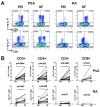Interleukin-17+CD8+ T cells are enriched in the joints of patients with psoriatic arthritis and correlate with disease activity and joint damage progression
- PMID: 24470327
- PMCID: PMC4158887
- DOI: 10.1002/art.38376
Interleukin-17+CD8+ T cells are enriched in the joints of patients with psoriatic arthritis and correlate with disease activity and joint damage progression
Abstract
Objective: Psoriatic arthritis (PsA) is associated with HLA class I genes, in contrast to the association with HLA class II in rheumatoid arthritis (RA). Since IL-17+ cells are considered important mediators of synovial inflammation, we sought to determine whether IL-17-producing CD8+ T cells may be found in the joints of patients with PsA and whether these cells might contribute to the disease process.
Methods: Mononuclear cells from paired samples of synovial fluid (SF) and peripheral blood (PB) from patients with PsA or patients with RA were stimulated ex vivo, and CD4- T cells were examined by flow cytometry for cytokine expression, cytotoxic markers, and frequencies of γ/δ or mucosal-associated invariant T cells. Clinical measures of arthritis activity (C-reactive protein [CRP] level, erythrocyte sedimentation rate [ESR], Disease Activity Score in 28 joints [DAS28]) and power Doppler ultrasound (PDUS) scores for the presence of active synovitis in the aspirated knee were recorded and assessed for correlations with immunologic markers.
Results: Within the CD3+ T cell compartment, both IL-17+CD4- (predominantly CD8+) and IL-17+CD4+ T cells were significantly enhanced in the SF compared to the PB of patients with PsA (P = 0.0003 and P = 0.002, respectively; n = 21), whereas in patients with RA, only IL-17+CD4+ T cells were increased in the SF compared to the PB (P = 0.008; n = 14). The frequency of IL-17+CD4- T cells in PsA SF was positively correlated with the CRP level (r = 0.52, P = 0.01), ESR (r = 0.59, P = 0.004), and DAS28 (r = 0.52, P = 0.01), and was increased in patients with erosive disease (P < 0.05). In addition, the frequency of IL-17+CD4- T cells positively correlated with the PDUS score, a marker for active synovitis (r = 0.49, P = 0.04).
Conclusion: These results show, for the first time, that the PsA joint, but not the RA joint, is enriched for IL-17+CD8+ T cells. Moreover, the findings reveal that the levels of this T cell subset are correlated with disease activity measures and the radiographic erosion status after 2 years, suggesting a previously unrecognized contribution of these cells to the pathogenesis of PsA.
© 2014 The Authors. Arthritis & Rheumatology is published by Wiley Periodicals, Inc. on behalf of the American College of Rheumatology.
Figures





Comment in
-
Editorial: emerging evidence for critical involvement of the interleukin-17 pathway in both psoriasis and psoriatic arthritis.Arthritis Rheumatol. 2014 May;66(5):1077-80. doi: 10.1002/art.38370. Arthritis Rheumatol. 2014. PMID: 24470140 No abstract available.
References
-
- Christophers E. Psoriasis—epidemiology and clinical spectrum. Clin Exp Dermatol. 2001;26:314–20. - PubMed
-
- Scott DL, Smith C, Kingsley G. Joint damage and disability in rheumatoid arthritis: an updated systematic review. Clin Exp Rheumatol. 2003;21:S20–7. - PubMed
-
- Kane D, Stafford L, Bresnihan B, FitzGerald O. A prospective, clinical and radiological study of early psoriatic arthritis: an early synovitis clinic experience. Rheumatology (Oxford) 2003;42:1460–8. - PubMed
Publication types
MeSH terms
Substances
Grants and funding
LinkOut - more resources
Full Text Sources
Other Literature Sources
Medical
Molecular Biology Databases
Research Materials
Miscellaneous

